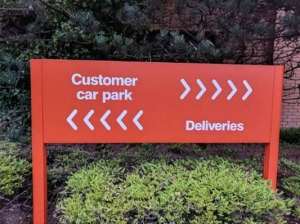
People aren’t perfect, mistakes happen and that can affect your bottom line directly (in the cost of fixing the mistake) or indirectly, by affecting your organisation’s reputation. So it’s important to have a system in place to eliminate errors.
“Fast is fine, but accuracy is everything.”
Wyatt Earp
Setting up a quality assurance and compliance system need not be an arduous task. When operational, the system allows your organisation to operate more efficiently, creating better results and allows you to focus on delivering better outcomes for your community, rather than re-doing work.
Why your brand needs a quality system
Proof reading your own work is difficult.
After hours working on something you can’t see the glaring error that a fresh pair of eyes can spot. I’ve seen ‘Course Black Pepper’ on the supermarket shelf – I bet you can name examples too.
Course correction
Are you actually doing what you intended? With all the best will in the world, it’s easy to get wrapped up in the detail and forget the bigger picture. An extra pair of eyes can help you get back on track.
Impartial view
Whilst something may make perfect sense to you, to others it might not. Different people may read the same text differently and have different sensitivities – a joke you find funny may offend others.
Compliance
All businesses are bound by competition and consumer law, and any advertising material or statements made by a business must be truthful and accurate. This includes any impressions created by what is said or displayed and fines for breaking rules can be costly.
Three steps to assuring quality communications
1. Decide what content needs to be checked, and to what degree
Whether it’s a Facebook post, a brochure or a newsletter, every piece of communication reflects back on your brand. They should all go through a quality assurance system but you should have different tiers. Legal and financial documents may be subject to regulatory compliance, and should be reviewed by lawyers or other professionals as appropriate, but they don’t need to see a Facebook post. Make sure the system you design works for your organisation. If you’ve never had a quality assurance or compliance system before, use a minimal viable product development technique and slowly improve the system as considerations arise.
“Everything should be as simple as possible, but no simpler”
Albert Einstein
2. Assign clear roles
Avoid confusion and delays by making sure everyone knows who is responsible for what.
- Content creator – this person has three tasks which are:
- Create the brief: this document lets everyone who is working on the project know:
- the purpose of the item to be created and reviewed
- the target segment (in terms of the intended audience)
- the objective
- the timeline
- Create the content or outsource to a writer or agency to complete the task. This may be one person or it may be the responsibility of your whole team.
- Ensure the material completes all steps of the process.
- Create the brief: this document lets everyone who is working on the project know:
- Brand champion – someone who really understands your business, what it stands for and, most importantly, is able to read the content from the reader’s point of view. This will ensure that they provide unbiased feedback and can spot any potential issues or questions that still need answering. You want your brand champion to be available full time as there will be occasions when you want to respond to news or a situation quickly, so they need to be on hand. Depending on the size of your organisation and the amount of content you produce, you may need several brand champions, but in the medium-term you will at least need two to cover for annual/sick leave.
- Other contributors – this is where you can make the process as complicated or as simple as it needs to be for your organisation. One of the factors to consider would be the cost of making a mistake, for example if you are going to print a document or brochure that is 20% of your marketing budget, then you may want to get another set of eyes to review the document for spelling mistakes etc. If you are writing something for your website, and a spelling mistake gets through, it can be easily corrected at no cost. As well as the cost, it is also important to look at the impact of making a mistake, including how it could impact your organisation’s reputation.
3. Choose a process that works for your team
You don’t need expensive software to keep quality on track. Paper based systems can be just as efficient as digital – what’s most important is that it’s easy for your team to adopt and follow.
You can create a quick and agile system for free; either a digital or paper system will work. Here’s my top tips:
- Digital process – my preferred method is to convert all documents that need approval to a pdf file (go to ‘save as’ and then in the ‘save as type’ drop down menu select pdf). Each contributor opens the file in Adobe Acrobat, adding a sticky note tool and simply writing ‘approved’, the note automatically marks the person’s name, date and time that the comment is made. If the content creator only needs one approval then this can be emailed to the appropriate person. If you need more than one signature then you can save the file on your server and let people know it is there for approval, either in person, by email of perhaps by a tool like Asana, where you can assign people tasks and issue completion dates. Either way, once approved the files can be stored in a central depository.
- Paper process – if digital doesn’t work for you, everything that needs approving gets printed out and circulated with each person signing and dating it. The approved documents then get put in a central depository (e.g. a ring binder) so you have a record of what has been approved, so there is no misunderstanding about what the final version is.
Your central depository also allows a quick reference system for existing materials so why start from scratch if you already have something suitable?
Whether you choose to monitor your communications on paper or online, always be sure to thoroughly check the final version in the medium on which it will appear (printed, on a laptop, on a mobile). Layout and context can change your meaning in unintended ways!


Protect your brand and save time
All it takes is a white board, your key team members and an hour to design a simple quality assurance and compliance system. A good system should help protect your brand and save time in rework, not be a drain on valuable staff resources.
Having worked for one of Australia’s leading food manufacturers and with five of the top six supermarkets in the UK, I’ve worked across quality assurance and compliance systems of varying complexity.






